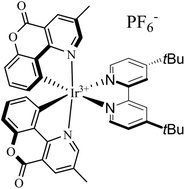Pump–probe XAS investigation of the triplet state of an Ir photosensitizer with chromenopyridinone ligands†
Abstract
The triplet excited state of a new Ir-based photosensitizer with two chromenopyridinone and one bipyridine-based ligands has been studied by pump–probe X-ray absorption near edge structure (XANES) spectroscopy coupled with DFT calculations. The excited state has a lifetime of 0.5 μs in acetonitrile and is characterized by very small changes of the local atomic structure with an average metal–ligand bond length change of less than 0.01 Å. DFT-based calculations allow the interpretation of the XANES in the energy range of ∼50 eV around the absorption edge. The observed transient XANES signal arises from an additional metal-centered Ir 5d vacancy in the excited state which appears as a result of electron transfer from the metal to the ligand. The overall energy shift of the excited state spectrum originates from the shift of 2p and unoccupied states induced by screening effects. The approach for the analysis of time-resolved spectra of 5d metal complexes is quite general and can also be used if excited and ground state structures are significantly different.

- This article is part of the themed collection: 28th International Conference on Photochemistry (ICP 2017)


 Please wait while we load your content...
Please wait while we load your content...